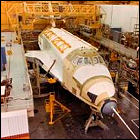 Construction begins on OV-101, a Space Shuttle intended for extensive atmospheric test flight and landings without ever going into space. Originally intended to bear the name Constitution, a letter-writing campaign by Star Trek fans convinces President Gerald Ford to request that NASA rename the first shuttle Enterprise. Much of the first shuttle’s structural details are simply dummy models of the correct shape and weight; her engines are never intended to fire. Though plans are drawn up to convert Enterprise into a space-worthy vehicle, they are never carried out: it’s deemed cheaper and faster to upgrade a structural test model of the shuttle instead.
Construction begins on OV-101, a Space Shuttle intended for extensive atmospheric test flight and landings without ever going into space. Originally intended to bear the name Constitution, a letter-writing campaign by Star Trek fans convinces President Gerald Ford to request that NASA rename the first shuttle Enterprise. Much of the first shuttle’s structural details are simply dummy models of the correct shape and weight; her engines are never intended to fire. Though plans are drawn up to convert Enterprise into a space-worthy vehicle, they are never carried out: it’s deemed cheaper and faster to upgrade a structural test model of the shuttle instead.

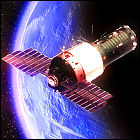 The Soviet Union launches its third space station, again based on the Almaz military space station architecture. Salyut 3 remains in orbit for over half a year, and is eventually visited by the crews of Soyuz 14 and Soyuz 15, though the latter mission fails to dock. Despite international agreements already in place to prevent the militarization of space, Salyut 3 is the first armed space station, packing a non-steerable anti-aircraft gun (for defending the station, though from what is never made clear). Fortunately, the space war never happens and Salyut 3 is never forced to defend itself.
The Soviet Union launches its third space station, again based on the Almaz military space station architecture. Salyut 3 remains in orbit for over half a year, and is eventually visited by the crews of Soyuz 14 and Soyuz 15, though the latter mission fails to dock. Despite international agreements already in place to prevent the militarization of space, Salyut 3 is the first armed space station, packing a non-steerable anti-aircraft gun (for defending the station, though from what is never made clear). Fortunately, the space war never happens and Salyut 3 is never forced to defend itself. The Soviet Union launches the Soyuz 14 mission, sending cosmonauts Yuri Artyukhin and Pavel Popovich to embark on a two-week stay aboard the Salyut 3 military space station. Though some medical science experiments are performed at Salyut 3, the majority of the crew’s time is taken up with observations of the Earth’s surface, essentially making Salyut 3 the first manned military surveillance satellite. Before leaving, the crew of two offloads supplies so that the new Salyut 3 crew can stay for several months.
The Soviet Union launches the Soyuz 14 mission, sending cosmonauts Yuri Artyukhin and Pavel Popovich to embark on a two-week stay aboard the Salyut 3 military space station. Though some medical science experiments are performed at Salyut 3, the majority of the crew’s time is taken up with observations of the Earth’s surface, essentially making Salyut 3 the first manned military surveillance satellite. Before leaving, the crew of two offloads supplies so that the new Salyut 3 crew can stay for several months.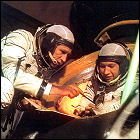 The Soviet space program continues with the launch of Soyuz 15, carrying cosmonauts Lev Dyomin and Gennadi Sarafanov. This is intended to be the second crew to occupy the Salyut 3 military space station, but spacecraft systems intended to automate the rendezvous and docking process fail. After manual dockings are attempted, the Soyuz vehicle is running low on fuel and the crew is recalled to Earth after only two days. (Trying to dodge questions about the nature of Salyut 3’s mission objectives, Soviet space authorities later claim that Soyuz 15 was never going to dock with the station.) No further crews are sent to board Salyut 3.
The Soviet space program continues with the launch of Soyuz 15, carrying cosmonauts Lev Dyomin and Gennadi Sarafanov. This is intended to be the second crew to occupy the Salyut 3 military space station, but spacecraft systems intended to automate the rendezvous and docking process fail. After manual dockings are attempted, the Soyuz vehicle is running low on fuel and the crew is recalled to Earth after only two days. (Trying to dodge questions about the nature of Salyut 3’s mission objectives, Soviet space authorities later claim that Soyuz 15 was never going to dock with the station.) No further crews are sent to board Salyut 3.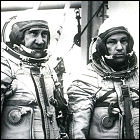 The Soviet Union launches Soyuz 16, a six-day manned space mission to test modifications to the Soyuz vehicle design ahead of
The Soviet Union launches Soyuz 16, a six-day manned space mission to test modifications to the Soyuz vehicle design ahead of 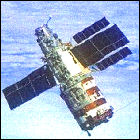 The Soviet Union launches its fourth orbital space station, Salyut 4. Much like Skylab, Salyut 4 is fitted with a solar telescope and X-ray astronomy equipment, which is trained on the X-ray source (and potential black hole) Cygnus X-1 during its flight. Three crews will go on to occupy Salyut 4 before it is deorbited in
The Soviet Union launches its fourth orbital space station, Salyut 4. Much like Skylab, Salyut 4 is fitted with a solar telescope and X-ray astronomy equipment, which is trained on the X-ray source (and potential black hole) Cygnus X-1 during its flight. Three crews will go on to occupy Salyut 4 before it is deorbited in 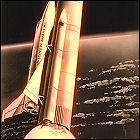 With the final Apollo spacecraft’s flight mere months away, an internal NASA document examining the progress of the Space Shuttle program, approved in
With the final Apollo spacecraft’s flight mere months away, an internal NASA document examining the progress of the Space Shuttle program, approved in  Construction begins on Space Shuttle Orbiter Vehicle 102 (OV-102 for short), the shuttle orbiter that NASA intends to launch as early as
Construction begins on Space Shuttle Orbiter Vehicle 102 (OV-102 for short), the shuttle orbiter that NASA intends to launch as early as  The two-man crew selected to become the second group of occupants for the Soviet Union’s Salyut 4 space station nearly rockets into disaster. Interstage connectors, intended to open simultaneously to allow the third stage of the booster to carry the Soyuz spacecraft into orbit, fail to open on cue, leaving the third stage dragging the dead weight of the spent second stage, changing the trajectory of the entire vehicle. The Soyuz capsule carrying cosmonauts Vasili Lazarev and Oleg Makarov is blasted free, and the two men experience acceleration of 23 Gs as the capsule roars toward a bruisingly rough emergency landing. As if that’s not bad enough, the Soyuz capsule lands perilously close to the USSR’s border with China, and rescue crews spend over 24 hours looking for the crew. The usually secretive Soviet space agency reluctantly reveals details of the mission to NASA, with whom they are collaborating ahead of the historic Apollo-Soyuz joint launch.
The two-man crew selected to become the second group of occupants for the Soviet Union’s Salyut 4 space station nearly rockets into disaster. Interstage connectors, intended to open simultaneously to allow the third stage of the booster to carry the Soyuz spacecraft into orbit, fail to open on cue, leaving the third stage dragging the dead weight of the spent second stage, changing the trajectory of the entire vehicle. The Soyuz capsule carrying cosmonauts Vasili Lazarev and Oleg Makarov is blasted free, and the two men experience acceleration of 23 Gs as the capsule roars toward a bruisingly rough emergency landing. As if that’s not bad enough, the Soyuz capsule lands perilously close to the USSR’s border with China, and rescue crews spend over 24 hours looking for the crew. The usually secretive Soviet space agency reluctantly reveals details of the mission to NASA, with whom they are collaborating ahead of the historic Apollo-Soyuz joint launch.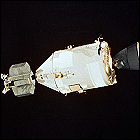 The final launch of an Apollo spacecraft takes place as the last Saturn rocket carries the American component of the Apollo-Soyuz Test Project into orbit. A cooperative international mission intended to see the Apollo capsule dock with a Soviet-launched Soyuz, the ASTP will be the last Apollo flight as the push toward the reusable Space Shuttle takes over NASA’s resources and planning. Aboard the Apollo command/service module are Commander Thomas Stafford, command module pilot Vance Brand, and docking module pilot Deke Slayton, the last of the seven original Mercury astronauts to reach space (heart conditions have prevented him from taking part in a mission until now). Soyuz 19, carrying cosmonauts Alexei Leonov and Valery Kubasov, lifts off a few hours earlier.
The final launch of an Apollo spacecraft takes place as the last Saturn rocket carries the American component of the Apollo-Soyuz Test Project into orbit. A cooperative international mission intended to see the Apollo capsule dock with a Soviet-launched Soyuz, the ASTP will be the last Apollo flight as the push toward the reusable Space Shuttle takes over NASA’s resources and planning. Aboard the Apollo command/service module are Commander Thomas Stafford, command module pilot Vance Brand, and docking module pilot Deke Slayton, the last of the seven original Mercury astronauts to reach space (heart conditions have prevented him from taking part in a mission until now). Soyuz 19, carrying cosmonauts Alexei Leonov and Valery Kubasov, lifts off a few hours earlier.  The last Apollo spacecraft to fly makes history by docking with a Soviet-launched Soyuz spacecraft in orbit, allowing the crews to visit each other and conduct joint scientific experiments. The first docking of the
The last Apollo spacecraft to fly makes history by docking with a Soviet-launched Soyuz spacecraft in orbit, allowing the crews to visit each other and conduct joint scientific experiments. The first docking of the 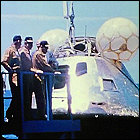 The “age of Apollo” comes to an unbreathable end in an incident during the return of the final Apollo spacecraft. Returning from their successful Apollo-Soyuz Test Project flight, astronauts Thomas Stafford, Deke Slayton and Vance Brand are exposed to fumes from their vehicle’s own reaction control thrusters, thanks to the thrusters firing after the capsule’s air vents open during descent toward the Pacific Ocean. Brand reportedly passes out momentarily due to the toxic fumes. All three astronauts are hospitalized for two weeks in Hawaii.
The “age of Apollo” comes to an unbreathable end in an incident during the return of the final Apollo spacecraft. Returning from their successful Apollo-Soyuz Test Project flight, astronauts Thomas Stafford, Deke Slayton and Vance Brand are exposed to fumes from their vehicle’s own reaction control thrusters, thanks to the thrusters firing after the capsule’s air vents open during descent toward the Pacific Ocean. Brand reportedly passes out momentarily due to the toxic fumes. All three astronauts are hospitalized for two weeks in Hawaii.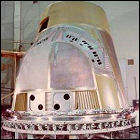 Construction begins on Space Shuttle Structural Test Article 099 (STA-099), a full-sized structural model of the shuttle built for stress and thermal testing. Four years later, NASA decides to abandon plans to refit the test shuttle Enterprise for space duty at great expense, instead opting to upgrade the STA-099 airframe into a spaceworthy vehicle, which will eventually be named Challenger. While the refit will still be expensive, it takes less time and money than a complete teardown and rebuild of Enterprise’s airframe, which was never intended for flight outside the atmosphere.
Construction begins on Space Shuttle Structural Test Article 099 (STA-099), a full-sized structural model of the shuttle built for stress and thermal testing. Four years later, NASA decides to abandon plans to refit the test shuttle Enterprise for space duty at great expense, instead opting to upgrade the STA-099 airframe into a spaceworthy vehicle, which will eventually be named Challenger. While the refit will still be expensive, it takes less time and money than a complete teardown and rebuild of Enterprise’s airframe, which was never intended for flight outside the atmosphere.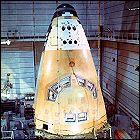 Fearing that the relatively sleek, aerodynamic design of the still-unflown American Space Shuttle is a hint that the vehicle could see use as an orbital bomber, the Kremlin orders the creation of the Soviet Space Shuttle program, though work on the vehicle, codenamed Buran (“Snowflake”), is primarily a crash program within the country’s defense department rather than the civilian branch of its space program. Within months, it is concluded that Buran will closely copy the American shuttle design due to the soundness of its aerodynamic design.
Fearing that the relatively sleek, aerodynamic design of the still-unflown American Space Shuttle is a hint that the vehicle could see use as an orbital bomber, the Kremlin orders the creation of the Soviet Space Shuttle program, though work on the vehicle, codenamed Buran (“Snowflake”), is primarily a crash program within the country’s defense department rather than the civilian branch of its space program. Within months, it is concluded that Buran will closely copy the American shuttle design due to the soundness of its aerodynamic design. With work having started mere days earlier on Buran, a Soviet version of the American space shuttle design, the Soviet Union’s space agency is given new marching orders to create a new generation of space station hardware, based on the experience gained thus far with the four Salyut space stations and their associated Almaz military space hardware. A modular design is chosen, with multiple docking ports and multiple station components launched over a period of time, concepts which will be tested with yet-to-be-launched Salyut stations. Frequently fighting with the Buran shuttle development program for money and resources (despite the fact that the two spacecraft are expected to be compatible), this new station will not be launched until 1986, almost exactly ten years later, at which time it will be known as Mir.
With work having started mere days earlier on Buran, a Soviet version of the American space shuttle design, the Soviet Union’s space agency is given new marching orders to create a new generation of space station hardware, based on the experience gained thus far with the four Salyut space stations and their associated Almaz military space hardware. A modular design is chosen, with multiple docking ports and multiple station components launched over a period of time, concepts which will be tested with yet-to-be-launched Salyut stations. Frequently fighting with the Buran shuttle development program for money and resources (despite the fact that the two spacecraft are expected to be compatible), this new station will not be launched until 1986, almost exactly ten years later, at which time it will be known as Mir.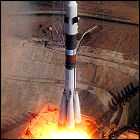 The Soviet Union launches cosmonauts Boris Volynov and Vitaly Zholobov aboard Soyuz 21, the first mission to the newly-orbited Salyut 5 military space station. Though a few scientific experiments are conducted, most of the crew’s activities involve military surveillance of Earth. The crew’s stay is intended to last as long as two months, though an emergency aboard the station will cut that stay short.
The Soviet Union launches cosmonauts Boris Volynov and Vitaly Zholobov aboard Soyuz 21, the first mission to the newly-orbited Salyut 5 military space station. Though a few scientific experiments are conducted, most of the crew’s activities involve military surveillance of Earth. The crew’s stay is intended to last as long as two months, though an emergency aboard the station will cut that stay short.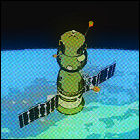 The Soviet Union launches Soyuz 22, a vehicle originally built as a backup for the Apollo-Soyuz Test Project. Unusually, the vehicle does not dock at the recently-launched Salyut 5 space station, but is instead placed in an unusual orbit that happens to make it easy to monitor a major NATO exercise near Norway. Cosmonauts Valery Bykovsky and Vladimir Aksyonov remain in that orbit for nearly eight days before returning to Earth.
The Soviet Union launches Soyuz 22, a vehicle originally built as a backup for the Apollo-Soyuz Test Project. Unusually, the vehicle does not dock at the recently-launched Salyut 5 space station, but is instead placed in an unusual orbit that happens to make it easy to monitor a major NATO exercise near Norway. Cosmonauts Valery Bykovsky and Vladimir Aksyonov remain in that orbit for nearly eight days before returning to Earth.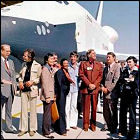 On schedule, the Space Shuttle Enterprise is rolled out of the Rockwell International plant in Palmdale, California to much public fanfare, a ceremony including Star Trek creator Gene Roddenberry and most of the cast who played the crew of the Enterprise’s fictional namesake (William Shatner was conspicuously absent). The timing of the rollout, ironically, was intended to roll the test shuttle – originally named Constitution – out of the hangar on Constitution Day during the bicentennial year.
On schedule, the Space Shuttle Enterprise is rolled out of the Rockwell International plant in Palmdale, California to much public fanfare, a ceremony including Star Trek creator Gene Roddenberry and most of the cast who played the crew of the Enterprise’s fictional namesake (William Shatner was conspicuously absent). The timing of the rollout, ironically, was intended to roll the test shuttle – originally named Constitution – out of the hangar on Constitution Day during the bicentennial year.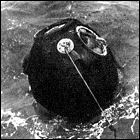 The Soviet Union’s Soyuz 23 mission lifts off from Baikonur Cosmodrome, intended for a stay of up to three months at the Salyut 5 space station. A serious malfunction of the automatic rendezvous gear forces an abort of the docking with the station, and cosmonauts Vyacheslav Zudov and Valery Rozhdestvensky are recalled to Earth, ending their orbit after just two days. But blizzard conditions near the landing site blow the Soyuz crew capsule off-course, resulting in the first-ever splashdown of the normally land-locked Soviet space program as Soyuz 23 plunges through the frozen surface of a lake. With their vehicle intact and functioning, the cosmonauts have to wait nine hours underwater for rescuers to bring the capsule to dry land.
The Soviet Union’s Soyuz 23 mission lifts off from Baikonur Cosmodrome, intended for a stay of up to three months at the Salyut 5 space station. A serious malfunction of the automatic rendezvous gear forces an abort of the docking with the station, and cosmonauts Vyacheslav Zudov and Valery Rozhdestvensky are recalled to Earth, ending their orbit after just two days. But blizzard conditions near the landing site blow the Soyuz crew capsule off-course, resulting in the first-ever splashdown of the normally land-locked Soviet space program as Soyuz 23 plunges through the frozen surface of a lake. With their vehicle intact and functioning, the cosmonauts have to wait nine hours underwater for rescuers to bring the capsule to dry land.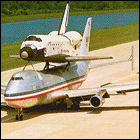 Space Shuttle Enterprise, mated to the heavily-modified Boeing 747 Shuttle Carrier Aircraft (SCA) for the first time, undergoes three “taxi tests” to enusre the structural stability of the two-vehicle combination on the runway before they ever take off. This is the first phase of a series of tests that will culminate, later in 1977, in a series of brief unpowered flights and landing tests using the Enterprise, verifying the shuttle’s gliding aerodynamics.
Space Shuttle Enterprise, mated to the heavily-modified Boeing 747 Shuttle Carrier Aircraft (SCA) for the first time, undergoes three “taxi tests” to enusre the structural stability of the two-vehicle combination on the runway before they ever take off. This is the first phase of a series of tests that will culminate, later in 1977, in a series of brief unpowered flights and landing tests using the Enterprise, verifying the shuttle’s gliding aerodynamics.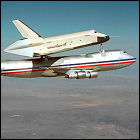 Mated to its Boeing 747 Shuttle Carrier Aircraft, Space Shuttle Enterprise goes airborne for the first time in the first of a series of “captive-inert” test flights. During these flights, there is no crew aboard Enterprise, nor are any of the test shuttle’s systems powered up; the flights are intended to make sure that the combination of the 747 and the Enterprise is capable of being flown safely. Further “captive-inert” flights are carried out over a ten-day period.
Mated to its Boeing 747 Shuttle Carrier Aircraft, Space Shuttle Enterprise goes airborne for the first time in the first of a series of “captive-inert” test flights. During these flights, there is no crew aboard Enterprise, nor are any of the test shuttle’s systems powered up; the flights are intended to make sure that the combination of the 747 and the Enterprise is capable of being flown safely. Further “captive-inert” flights are carried out over a ten-day period.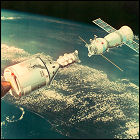 With the 1972 agreement having resulted in the successful Apollo-Soyuz Test Project, the United States and the Soviet Union formally renew the Space Cooperation Agreement. As an immediate goal to build on Apollo-Soyuz, both countries hold tentative discussions about docking the American Space Shuttle (which, it is still assumed, will be in space before the 1970s are out) and a Soviet Salyut space station. Though the shuttle’s first flight is still being delayed, the biggest hurdle will prove to be international relations, specifically a renewed chilling of the Cold War thanks to the Soviet Union’s 1979 invasion of Afghanistan.
With the 1972 agreement having resulted in the successful Apollo-Soyuz Test Project, the United States and the Soviet Union formally renew the Space Cooperation Agreement. As an immediate goal to build on Apollo-Soyuz, both countries hold tentative discussions about docking the American Space Shuttle (which, it is still assumed, will be in space before the 1970s are out) and a Soviet Salyut space station. Though the shuttle’s first flight is still being delayed, the biggest hurdle will prove to be international relations, specifically a renewed chilling of the Cold War thanks to the Soviet Union’s 1979 invasion of Afghanistan.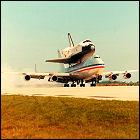 Mounted on the back of Boeing 747, the Space Shuttle Enterprise takes off on its first crewed flight, the first of three “captive-active” flights which see Enterprise remain in place on its carrier aircraft. For the first time, Enterprise’s computers, avionics and other flight systems are powered up in a full-up, hour-long dress rehearsal of an eventual free-flight landing test at 15,000 feet. The first crew of the Space Shuttle Enterprise consists of astronauts Fred Haise and Gordon Fullerton.
Mounted on the back of Boeing 747, the Space Shuttle Enterprise takes off on its first crewed flight, the first of three “captive-active” flights which see Enterprise remain in place on its carrier aircraft. For the first time, Enterprise’s computers, avionics and other flight systems are powered up in a full-up, hour-long dress rehearsal of an eventual free-flight landing test at 15,000 feet. The first crew of the Space Shuttle Enterprise consists of astronauts Fred Haise and Gordon Fullerton.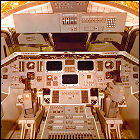 Riding the back of a modified Boeing 747, Space Shuttle Enterprise ascends to 22,000 feet for her second “active-captive” test flight, with all systems powered up and a crew aboard (astronauts Joe Engle and Richard Truly). The combined vehicle reaches speeds of over 300 miles per hour, and angles for “dropoff” – for upcoming test flights in which the Enterprise will actually separate from the 747 and glide to its landing strip – are studied for future reference.
Riding the back of a modified Boeing 747, Space Shuttle Enterprise ascends to 22,000 feet for her second “active-captive” test flight, with all systems powered up and a crew aboard (astronauts Joe Engle and Richard Truly). The combined vehicle reaches speeds of over 300 miles per hour, and angles for “dropoff” – for upcoming test flights in which the Enterprise will actually separate from the 747 and glide to its landing strip – are studied for future reference.